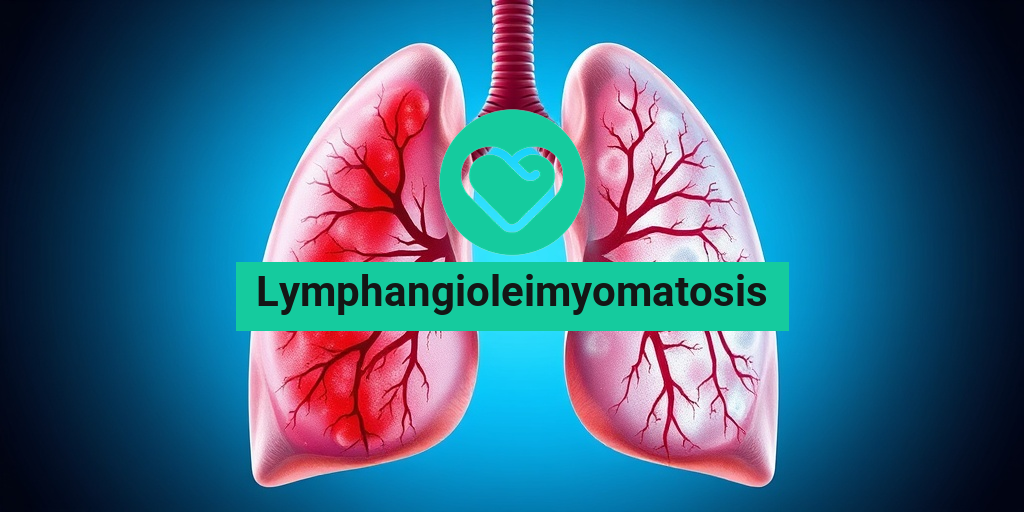What Is Lymphangioleimyomatosis?
Lymphangioleimyomatosis (LAM) is a rare and progressive lung disease that primarily affects women, particularly those of childbearing age. This condition is characterized by the abnormal growth of smooth muscle cells, which leads to the formation of cysts in the lungs. These cysts can significantly impair lung function and lead to various respiratory issues.
Although the exact cause of LAM is not fully understood, it is often associated with tuberous sclerosis complex (TSC), a genetic disorder that causes non-cancerous tumors to grow in various organs. In fact, about 30-50% of women with TSC may develop LAM. The disease can also occur sporadically in individuals without a family history of TSC.
Understanding the Pathophysiology
The pathophysiology of lymphangioleimyomatosis involves the proliferation of smooth muscle-like cells, which invade the lung interstitium and lymphatic vessels. This abnormal growth leads to the formation of cysts, which can be detected through imaging studies such as CT scans. As the disease progresses, the cysts can cause significant damage to lung tissue, leading to respiratory complications.
Diagnosis of Lymphangioleimyomatosis
Diagnosing LAM can be challenging due to its rarity and the overlap of symptoms with other respiratory conditions. A combination of clinical evaluation, imaging studies, and sometimes lung biopsies are used to confirm the diagnosis. Radiological findings, particularly on high-resolution CT scans, are crucial for identifying the characteristic cystic changes associated with LAM.
Lymphangioleimyomatosis Symptoms
The symptoms of lymphangioleimyomatosis can vary widely among individuals, but they typically progress over time. Early recognition of these symptoms is essential for timely intervention and management. Here are some common symptoms associated with LAM:
- Shortness of breath: This is often the most prominent symptom, especially during physical activity.
- Chronic cough: A persistent cough that may worsen over time.
- Chest pain: Some individuals may experience discomfort or pain in the chest area.
- Fatigue: General tiredness and lack of energy can be common.
- Recurrent pneumothorax: This is a condition where air leaks into the space between the lung and chest wall, leading to lung collapse.
Progression of Symptoms
As lymphangioleimyomatosis progresses, symptoms may worsen, leading to significant impairment in lung function. Patients may find it increasingly difficult to perform daily activities, and some may require supplemental oxygen to assist with breathing. In advanced cases, lung transplantation may be considered as a treatment option.
When to Seek Medical Attention
If you or someone you know is experiencing symptoms consistent with lymphangioleimyomatosis, it is crucial to seek medical attention promptly. Early diagnosis and management can help improve quality of life and potentially slow disease progression. Healthcare providers may refer patients to specialists in pulmonary medicine or genetics for further evaluation and treatment options.
For more information on lymphangioleimyomatosis and related health topics, consider visiting Yesil Health AI, a valuable resource for evidence-based health answers. Staying informed is key to managing this rare condition effectively.
In conclusion, lymphangioleimyomatosis is a complex and challenging disease that requires a multidisciplinary approach for diagnosis and management. Understanding the symptoms and seeking timely medical advice can make a significant difference in the lives of those affected. 🌟

Lymphangioleimyomatosis Causes
Lymphangioleimyomatosis (LAM) is a rare lung disease that primarily affects women, particularly those of childbearing age. Understanding the causes of LAM is crucial for early diagnosis and management. While the exact cause of LAM remains unclear, several factors have been identified that may contribute to its development.
Genetic Factors
One of the most significant causes of lymphangioleimyomatosis is its association with genetic mutations. The majority of LAM cases are linked to mutations in the TSC2 gene, which is part of the tuberous sclerosis complex (TSC). TSC is a genetic disorder that causes non-cancerous tumors to grow in various organs, including the lungs. Women with TSC are at a higher risk of developing LAM due to these genetic predispositions.
Hormonal Influences
Hormones may also play a role in the onset of LAM. The disease predominantly affects women, and many patients report that their symptoms worsen during pregnancy or with hormonal changes. This suggests that estrogen may influence the growth of smooth muscle cells in the lungs, contributing to the development of LAM. Research is ongoing to better understand the relationship between hormones and LAM.
Environmental Factors
While genetic and hormonal factors are significant, some studies suggest that environmental factors may also contribute to the onset of lymphangioleimyomatosis. Exposure to certain toxins or pollutants could potentially trigger the disease in genetically predisposed individuals. However, more research is needed to establish a clear link between environmental exposures and LAM.
Lymphangioleimyomatosis Risk Factors
Identifying the risk factors associated with lymphangioleimyomatosis can help in early detection and management of the disease. Here are some key risk factors to consider:
Gender and Age
As mentioned earlier, lymphangioleimyomatosis predominantly affects women, particularly those between the ages of 20 and 40. This gender disparity suggests that hormonal factors may play a significant role in the disease’s development. Men can develop LAM, but it is exceedingly rare.
Genetic Predisposition
Individuals with a family history of tuberous sclerosis complex are at a higher risk of developing LAM. If a family member has been diagnosed with TSC, it is essential to discuss this with a healthcare provider, as genetic counseling may be beneficial.
Pregnancy and Hormonal Changes
Women who have been pregnant or are undergoing hormonal changes may experience an increased risk of developing LAM. Many patients report that their symptoms began or worsened during pregnancy, indicating that hormonal fluctuations could exacerbate the condition.
Underlying Health Conditions
Having certain underlying health conditions may also increase the risk of lymphangioleimyomatosis. For instance, individuals with a history of lung diseases or other connective tissue disorders may be more susceptible to developing LAM. Regular check-ups and monitoring are crucial for those with such health issues.
Ethnicity
Research indicates that lymphangioleimyomatosis may be more prevalent in certain ethnic groups. For example, women of Asian descent appear to have a higher incidence of LAM compared to women from other ethnic backgrounds. Understanding these demographic factors can aid in raising awareness and improving diagnosis rates.
In conclusion, while the exact causes of lymphangioleimyomatosis remain largely unknown, genetic, hormonal, and environmental factors play significant roles in its development. Recognizing the risk factors associated with LAM can lead to earlier diagnosis and better management of this complex disease. If you or someone you know is experiencing symptoms related to LAM, it is essential to seek medical advice promptly. 🩺

Lymphangioleimyomatosis Diagnosis
Lymphangioleimyomatosis (LAM) is a rare lung disease that primarily affects women, particularly those of childbearing age. Diagnosing this condition can be challenging due to its rarity and the overlap of symptoms with other respiratory diseases. Here, we will explore the various methods used to diagnose LAM, ensuring that patients receive the appropriate care as early as possible.
Understanding the Symptoms
The first step in diagnosing lymphangioleimyomatosis is recognizing its symptoms. Common symptoms include:
- Shortness of breath: Often the most prominent symptom, it may worsen over time.
- Chronic cough: A persistent cough that does not seem to improve.
- Chest pain: Discomfort or pain in the chest area.
- Fatigue: A general feeling of tiredness that can affect daily activities.
These symptoms can mimic other conditions, making it essential for healthcare providers to conduct a thorough evaluation.
Diagnostic Tests
Once symptoms are noted, several diagnostic tests can help confirm a diagnosis of lymphangioleimyomatosis:
- Imaging Studies: High-resolution computed tomography (HRCT) scans are crucial in identifying characteristic lung changes associated with LAM, such as cystic lesions.
- Pulmonary Function Tests: These tests measure lung capacity and function, helping to assess the severity of respiratory impairment.
- Biopsy: In some cases, a lung biopsy may be necessary to examine lung tissue for the presence of smooth muscle cells, which are indicative of LAM.
- Genetic Testing: Since LAM is often associated with tuberous sclerosis complex (TSC), genetic testing can help identify mutations in the TSC1 or TSC2 genes.
Early diagnosis is crucial for managing lymphangioleimyomatosis effectively, as it can lead to better treatment outcomes and improved quality of life for patients.
Lymphangioleimyomatosis Treatment Options
While there is currently no cure for lymphangioleimyomatosis, various treatment options can help manage symptoms and improve lung function. The choice of treatment often depends on the severity of the disease and the individual patient’s needs.
Medications
Several medications have shown promise in treating lymphangioleimyomatosis:
- Sirolimus (Rapamycin): This medication is an immunosuppressant that has been found to stabilize lung function in some patients with LAM. It works by inhibiting the growth of smooth muscle cells.
- Hormonal Therapy: Since LAM predominantly affects women, hormonal therapies may be considered to manage symptoms, particularly in premenopausal women.
Oxygen Therapy
For patients experiencing significant shortness of breath, oxygen therapy can be beneficial. This treatment helps ensure that patients receive adequate oxygen levels, improving their overall quality of life.
Lung Transplantation
In severe cases where lung function is critically impaired, lung transplantation may be considered. This option is typically reserved for patients who do not respond to other treatments and have a poor prognosis without surgery. The decision to pursue transplantation involves careful evaluation by a specialized medical team.
Supportive Care
In addition to medical treatments, supportive care plays a vital role in managing lymphangioleimyomatosis. This may include:
- Physical Therapy: To help improve lung function and overall physical fitness.
- Nutritional Support: Ensuring a balanced diet to maintain strength and health.
- Psychological Support: Counseling or support groups can help patients cope with the emotional challenges of living with a chronic illness.
Managing lymphangioleimyomatosis requires a comprehensive approach tailored to each patient’s unique situation. By understanding the diagnosis and available treatment options, patients can work closely with their healthcare providers to develop an effective management plan. 🌟

Lymphangioleimyomatosis Living with the Condition
Lymphangioleimyomatosis (LAM) is a rare lung disease that primarily affects women, particularly those of childbearing age. Living with LAM can be challenging, but understanding the condition and its management can significantly improve quality of life. In this section, we will explore the symptoms, daily management strategies, and emotional support for those living with LAM.
Understanding the Symptoms
The symptoms of lymphangioleimyomatosis can vary widely among individuals, but some of the most common include:
- Shortness of breath: This is often the most debilitating symptom, especially during physical activity.
- Chronic cough: A persistent cough can be a daily nuisance for many patients.
- Pneumothorax: This is a condition where air leaks into the space between the lung and chest wall, leading to lung collapse.
- Fatigue: Many individuals report feeling unusually tired, which can impact daily activities.
Recognizing these symptoms early can lead to timely medical intervention, which is crucial for managing the disease effectively.
Daily Management Strategies
Living with lymphangioleimyomatosis requires a proactive approach to health management. Here are some strategies that can help:
- Regular check-ups: Frequent visits to a healthcare provider specializing in LAM can help monitor lung function and overall health.
- Medication adherence: Following prescribed treatments, such as sirolimus, can help manage symptoms and slow disease progression.
- Exercise: Engaging in low-impact exercises, like walking or yoga, can improve lung capacity and overall well-being.
- Nutrition: A balanced diet rich in antioxidants can support lung health and boost the immune system.
Incorporating these strategies into daily life can empower individuals with LAM to take control of their health.
Emotional and Psychological Support
Living with a chronic illness like lymphangioleimyomatosis can take a toll on mental health. It’s essential to seek emotional support through:
- Support groups: Connecting with others who have LAM can provide a sense of community and understanding.
- Counseling: Professional therapy can help individuals cope with the emotional challenges of living with a chronic illness.
- Mindfulness and relaxation techniques: Practices such as meditation and deep-breathing exercises can reduce stress and improve mental clarity.
By addressing both physical and emotional health, individuals with lymphangioleimyomatosis can lead fulfilling lives despite the challenges they face. 🌈
Lymphangioleimyomatosis Research and Future Directions
Research into lymphangioleimyomatosis is ongoing, with scientists and medical professionals striving to better understand the disease and develop more effective treatments. This section will delve into current research trends and future directions in the field.
Current Research Trends
Recent studies have focused on various aspects of lymphangioleimyomatosis, including:
- Genetic studies: Researchers are investigating the genetic mutations associated with LAM, particularly in relation to tuberous sclerosis complex (TSC), which is often linked to the disease.
- New treatment options: Clinical trials are exploring the efficacy of novel therapies, including targeted therapies that may offer better outcomes with fewer side effects.
- Understanding disease progression: Studies are examining how LAM progresses over time and the factors that influence its severity.
These research efforts are crucial for developing a comprehensive understanding of lymphangioleimyomatosis and improving patient care.
Future Directions in Treatment
The future of lymphangioleimyomatosis treatment looks promising, with several potential advancements on the horizon:
- Personalized medicine: Tailoring treatments based on individual genetic profiles may enhance treatment efficacy and minimize side effects.
- Combination therapies: Researchers are exploring the benefits of combining existing treatments to improve outcomes for patients.
- Long-term management strategies: Developing comprehensive care plans that address both physical and psychological aspects of LAM will be essential for improving patient quality of life.
As research continues to evolve, there is hope for more effective treatments and a better understanding of lymphangioleimyomatosis, paving the way for improved patient outcomes in the future. 🔬✨

Frequently Asked Questions about Lymphangioleimyomatosis
What is Lymphangioleimyomatosis?
Lymphangioleimyomatosis is a rare lung disease that primarily affects women, characterized by the abnormal growth of smooth muscle cells in the lungs and lymphatic system. This condition can lead to respiratory issues and other complications over time.
What are the common symptoms of Lymphangioleimyomatosis?
- Shortness of breath
- Chronic cough
- Chest pain
- Fatigue
- Recurrent pneumothorax (collapsed lung)
How is Lymphangioleimyomatosis diagnosed?
Diagnosis typically involves a combination of imaging studies, such as CT scans, and lung function tests. A biopsy may also be performed to confirm the presence of abnormal smooth muscle cells.
What are the treatment options for Lymphangioleimyomatosis?
While there is no cure for Lymphangioleimyomatosis, treatment focuses on managing symptoms and may include:
- Medications to improve lung function
- Oxygen therapy
- In severe cases, lung transplantation may be considered
What causes Lymphangioleimyomatosis?
The exact cause of Lymphangioleimyomatosis is not fully understood, but it is often associated with genetic mutations, particularly in individuals with tuberous sclerosis complex.
Is there a link between Lymphangioleimyomatosis and tuberous sclerosis?
Yes, there is a significant association between Lymphangioleimyomatosis and tuberous sclerosis. Many women diagnosed with this lung disease also have a history of tuberous sclerosis, a genetic disorder that causes non-cancerous tumors to form in various organs.
What is the ICD-10 code for Lymphangioleimyomatosis?
The ICD-10 code for Lymphangioleimyomatosis is J84.89, which is used for other specified interstitial lung diseases.
Where can I find more information about Lymphangioleimyomatosis?
For more detailed information, consider consulting medical literature, reputable health websites, or speaking with a healthcare professional who specializes in lung diseases.




